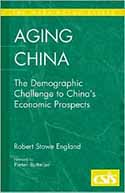Praeger Books and Center for Strategic and International Studies
Washington Papers Series
Published April 2005 by Greenwood Publishing Group, Incorporated
Forward by Pieter Bottelier
Book Review of Aging China by Xiaochun Qiao
The China Quarterly,< Volume 182, Issue 1, March 2006, pp. 182-183
Book Review by Xiaochun Qiao The China Quarterly, Volume 182, Issue 1, March 2006, pp. 182-183 Aging China: The Demographic Challenge to China’s Economic Prospects. By ROBERT STOWE ENGLAND. [Westport, CT and London: Praeger Publishers, 2005. xv_135 pp. £16.99. ISBN: 0-275-98684-5.]
This book is based on the author’s studies on China’s ageing population and on research carried out by the Global Aging Initiative at the Center for Strategic and International Studies in Washington, DC into the present and future impact of ageing on China.
Robert Stowe England aims to demonstrate that ageing in China, the world’s largest developing country, will experience a quite different course from that of developed countries or even of countries whose ageing levels are higher than China’s. The author tackles the issue from two angles: the demographic impacts on the one hand, and socioeconomic and institutional consequences on the other. In the section on demographics, the author argues that China is on the brink of a rapid transformation – caused by increased longevity and a nation-oriented family planning policy implemented for over 30 years – into a high-level ageing society in which old people will make up a large proportion of the population.
Since children are almost the only source of support for the elderly in China, especially in rural areas, the rapid decrease in their number will considerably undermine the conventional means of family support. In the socio-economic and institutional section, the author shows that this phenomenon is taking place in a country where the majority of the population have low standards of living and do not benefit from high standards of social security. He argues that China will begin its rapid ageing before it has completed its transition to the level of moderately developed countries. The author discusses the challenges that China is facing in the context of current economic problems such as the ongoing retrenchment of benefits for employees of state-owned enterprises, unemployment, the need for a stronger safety net and for reforms aimed at promoting growth in rural areas, rampant corruption, banking debts, and the necessity of increasing the coverage and costs of social security. All these challenges will probably constrain the benefits of future economic development and cause difficulties for the Chinese government in tackling ageing problems.
According to the author, the ageing of China’s population in the 21st century will produce two integrating consequences as far as people’s lives and the nation’s development are concerned. It will lead to a considerable decrease of living standards for the elderly who will become a huge burden on their families; it will also slow down the economic development. The main argument of the book is to discuss if ageing in China will hinder China’s economic development and reform efforts in the first half of this century under the unfavourable conditions mentioned above. The author examines almost all the factors which are likely to affect the improvement of the social security system for the elderly and the economic development, and concludes that the Chinese government faces enormous challenges as it tries to steer a rapidly ageing nation toward a market economy and orderly integration into the global economy. He argues that ageing will reshape China through its impact on various aspects of society.
As a matter of fact, Chinese scholars in different disciplines look at the consequences of China’s ageing in different ways. Chinese sociologists focus on the well-being and living conditions of the elderly as well as on intergenerational relationships, whereas economists turn their attention to the impact of this phenomenon on the nation’s economic development and the capacity of economic support to the elderly in future. Interestingly sociologists, in general, tend to be more pessimistic, and economists more optimistic, as can be seen from some interviews conducted by Dr. England in China.
The theory embedded in the Chinese economists’ argument is that longer life leads to a higher accumulation of assets. However, Robert Stowe England’s opinion on the subject differs as he is convinced that China will face enormous challenges as its population is ageing rapidly. This reviewer finds that the author’s argument more convincing because it integrates economic theories into the reality of the Chinese situation, especially as it takes into account the relationship between economic and demographic factors. Although it is hard to prove the extent to which ageing will undermine the economic development of China in future, there are some indirect evidences based on what has already occurred in some European countries and Japan, where fast ageing has, to some extent, resulted in a slowing down of the economic development. Such experiences have attracted scholars’ attention, including the author of this book, to assess the negative consequences of ageing in China. One of the reasons why Chinese economists have an optimistic view of ageing in china, I suppose, is that their vision is easily blurred by the currently prosperous economic situation. However, the economy cannot be separated from its causes, and Robert Stowe England does attempt to shed a light on the linkage between the ageing of China’s population and the country’s economic development.
This book will make interesting reading not only for Chinese studies scholars but also politicians, investors and business people. It can be used as reference in teaching in Chinese studies, pension and social security, sociology, gerontology, social demography, developing economics and even business.
XIAOCHUN QIAO
The above review is reprinted in its entirety by permission of The China Quarterly and Xiaochun Qiao.
The China Quarterly is the leading scholarly journal in its field, covering all aspects of contemporary China including Taiwan.
For more information, click the link below:

